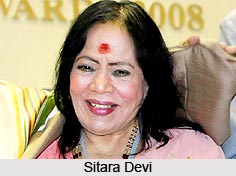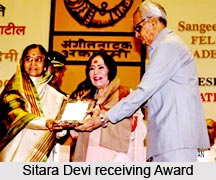 Sitara Devi was an eminent Indian kathak dancer. Popularly known as `kathak queen`, she had set her own style inspiring many generations of artists and audience. She was described as `Nritya Samragini` by legendary poet Rabindranath Tagore. Her family had devoted their life for four generations to develop Kathak and discover the nuances of the lost and missing links of this creative form. Eventually during the lifetime of her father, kathak re-attained its lost glory and emerged as an important pillar of Indian dancing. Sitara continued the tradition, and contributed immensely to the popularity of this art form during her career which spanned more than six decades. After prolonged illness, she breathed her last on November 25, 2014, at Jaslok Hospital in Mumbai. She was 94.
Sitara Devi was an eminent Indian kathak dancer. Popularly known as `kathak queen`, she had set her own style inspiring many generations of artists and audience. She was described as `Nritya Samragini` by legendary poet Rabindranath Tagore. Her family had devoted their life for four generations to develop Kathak and discover the nuances of the lost and missing links of this creative form. Eventually during the lifetime of her father, kathak re-attained its lost glory and emerged as an important pillar of Indian dancing. Sitara continued the tradition, and contributed immensely to the popularity of this art form during her career which spanned more than six decades. After prolonged illness, she breathed her last on November 25, 2014, at Jaslok Hospital in Mumbai. She was 94.
Early Life of Sitara Devi
She was born in Kolkata (then Calcutta) on November 8, 1920 in a Brahmin family. She was named Dhanalakshmi (nicknamed Dhanno) as she was born on Dhanteras. Her father was Sukhadev Maharaj and mother was Matsya Kumari.
Career of Sitara Devi
Sitara Devi`s career started under the tutelage of her father. Her father, a Vaishanavite scholar of Sanskrit, earned his livelihood by teaching and performing kathak dances in different parts of India. Kathak was both passion and source of living for her father. He passed on this creative form to his daughters, Alaknanda, Tara, and Dhanno; and his sons, Chaube and Pande.
Maharaj had met Rabindranath Tagore who supported him to revive the lost forms of Indian performing arts like kathak. Encouragement from such a dignified person motivated him to realize this goal by contributing to reforming the kathak style of dancing. However, during that period, this dance was practiced only by the nautch girls or boys. The girls of decent families were not encouraged to learn this dance.
Maharaj decided to give religious inputs to the content of this dance. The inputs made the style of the dance quite different from the content used by the nautch girls. He also decided to teach kathak to his daughters and sons.
Owing to his initiative, the elders of his community were outraged. Maharaj was virtually ex-communicated. Maharaj and his family members had to face the rage of the community members. His daughters were almost declared prostitutes. But all these words of outrage did not lessen Maharaj`s passion and determination. He changed his residence, and settled in another area of Varanasi.
Maharaj went a step further by establishing a dance school where he taught kathak to various children including his own daughters and sons. He even encouraged the admission of the children of prostitute.
Once, the law enforcement authorities visited the school to know about its affairs. Maharaj presented a performance based on the tales of the Mahabharata. The performance was appreciated by the authorities. At that time, Sitara was very young. She had been watching her sister who was twenty years senior to her, learning dance. Sitara had managed to learn dancing quite well just by observing her sister and self-practice.
 Like the tradition of that time, Sitara was to be married when she was a small girl of eight but she resisted and expressed her wish to study in a school. Finally, the marriage did not take place and she was admitted into the Kamachhagarh High School.
Like the tradition of that time, Sitara was to be married when she was a small girl of eight but she resisted and expressed her wish to study in a school. Finally, the marriage did not take place and she was admitted into the Kamachhagarh High School.
Once in her school, a dance drama based on the mythological story of Savitri and Satyavan was to be essayed in a cultural program. The school was looking for a student to perform the dance drama. Sitara had expressed her desire and impressed her teacher by showing her impromptu dance performance. She was immediately selected and was also assigned the task of teaching the dance to her co-performers in the sequence. After the performance, a local newspaper named `Aaj` reported about the dance emphasizing that a little girl name Dhanno had mesmerised the audience by her enchanting dance performance. Her father came to know about the news. Impressed by her daughter, he changed her name to Sitara meaning the star. He assigned his elder daughter Tara for teaching dance to Sitara.
By the time Sitara had turned ten, she was giving solo performances, mostly during the fifteen-minute recess during movies in a movie theatre of her father`s friend. Her dedication to dance left her with very little time, and she did not continue her schooling. Her family shifted to Bombay (now Mumbai) when she was eleven.
Soon after reaching Bombay, Sitara gave a kathak performance in Atiya Begum Palace before a select audience, which included Rabindranath Tagore, Sarojini Naidu and Sir Cowasji Jehangir. Impressed by her dancing talent, Tagore wanted her to give a special performance in Tata Palace of the Tata Group. There after a three-hour performance, she was felicitated by Tagore in the traditional Indian style. She received a shawl and a Rs. 50 as a token of appreciation.
She debuted at Jehangir Hall (Mumbai), then the nerve centre of metro`s cultural life. This was the beginning of a dancing career spanning more than six decades. When she was just twelve, Sitara was recruited by Niranjan Sharma, a filmmaker and a dance director. She performed dance sequences in some Hindi movies including `Usha Haran` (1940), `Nagina` (1951), `Roti`, `Vatan` (1954), `Anjali` (1957) etc.
She performed a Holi dance dressed as a boy in the famous movie `Mother India` (1957). This was her last dance in any movie. She stopped performing dances in movies, as it was affecting her passion for excelling in the classical dance, kathak.
 Although her forte was kathak, she also learned Bharatanatyam, many forms of folk dances of India, Russian ballet, and some more dances of the western world.
Although her forte was kathak, she also learned Bharatanatyam, many forms of folk dances of India, Russian ballet, and some more dances of the western world.
In her later life, she was working on compiling a book encapsulating the researches done by her father and her in the field of dancing, especially in kathak style of dancing. All through her dancing career, she had been teaching many Bollywood celebrities including Madhubala, Rekha, Mala Sinha, and Kajol to hone the skills required for kathak dancing.
Achievements of Sitara Devi
According to Sitara Devi, her greatest award is from Tagore. After observing one of her performances, when Sitara Devi was only sixteen years old, she was described as `Nritya Samragini` by Rabindranath Tagore, the Nobel Laureate. Her other awards are as follows:
•In 1969, she was honoured with Sangeet Natak Akademi Award.
•In 1973, she was awarded with Padma Shree.
•In 1995, she received Kalidas Samman.
Personal Life of Sitara Devi
Sitara was married to Nazir Ahmed Khan, K. Asif, and then to Pratap Barot, with whom she had a son, Ranjit Barot.




